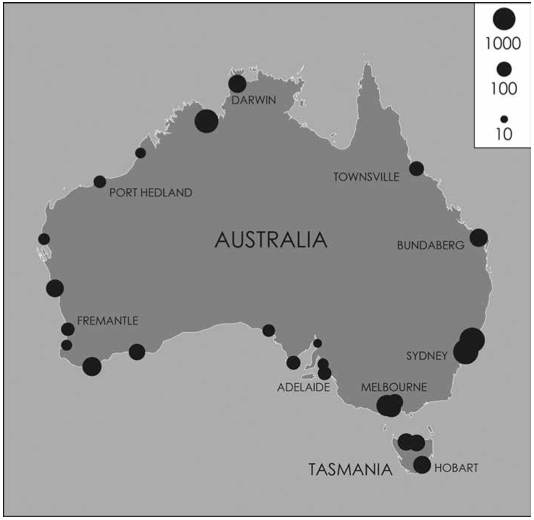Planning for dangerous contingencies is the stock in trade of generals and militaries. So you'd think that climate change would be at the top of the list of future scenarios for the boffins of the Australian Defence Force.
As we've long argued here at New Matilda, climate change is by far the most dangerous threat that confronts Australia in coming decades. But Australia's military and security apparatus has been slow to come to grips with the scope and significance of the problem.
Unlike the US military, which started building a sophisticated awareness of the world's warming climate into its defence planning years ago, the ADF still gives climate risks and accompanying natural disaster scenarios a much lower priority than the more traditional tasks of fighting wars and policing borders.
That might be about to change, with the release this week of an important new paper by the Australian Strategic Policy Institute about climate and the ADF. Entitled Heavy Weather: Climate and the Australian Defence Force, the special report argues that climate change is already affecting the force structure and capabilities of the ADF, and that the Australian military will have to do a lot more planning to deal with the uncertainties and risks that a warmer future entails.

A map published in the report shows why. The dots on the map represent cities where data is available regarding storm surges. In a future in which sea level is expected to rise by at least half a metre, some centres will see one-in-a-hundred year flooding events annually. This is just one snap-shot on the scale of the adaptation problem Australia faces.
Perhaps the most obvious issue is natural disaster response, which Anthony Bergin, one of the report's authors, has done important work on before. The ADF has been extensively deployed in recent years responding to natural disasters. For instance, the 2011 deployment in Queensland in response to the state's devastating floods was one of the largest domestic deployments by Australian armed forces in our history.
Climate change is making Australia more vulnerable to catastrophes, as a range of important studies have shown. When disaster strikes, the ADF will increasingly be called upon to help pick up the pieces. For instance, the ADF is the only institution in the country that deploys large hospital ships, big transport planes, fleets of helicopters and an Engineering Corps that can get fresh water and electricity running in a disaster zone.
Because of their role in disaster response, engineering units are a critical capability for a climate-ready defence force. The issue is not just about whizz-bang machines, but also concerns human capital: recruiting and retaining skilled tradespeople remains one of the ADF's greatest challenges. One of the report's key recommendations is to invest more in engineering capability, as it is these units that will hit the ground first in the wake of a cyclone or bushfire.
Of course, the ADF is more than just a high-tech fire brigade. It's also a huge and unwieldy organisation, with hundreds of bases and tens of thousands of personnel. As such, it has a significant carbon footprint of its own. The report argues that the ADF can and should get greener in the way it consumes energy and resources, if only to stretch a generally lean defence budget further.
Defence itself will also be affected by the warming climate. The report points out that hotter temperatures and rising sea levels will have huge implications for the Air Force's runways (will they melt?) and the Navy's docks and ports (will they flood?). The RAAF's Tindal air base near Darwin currently has open-air hangers, for instance. Expensive new jet fighters like the Super Hornets and the Joint Strike Fighters will therefore be exposed to more heatwaves, potentially affecting their maintenance.
All this highlights the need for Defence to be better informed. There are currently very few climate scientists working in or advising the ADF, and Defence could be doing much better in terms of collecting climate data across its vast continental footprint. The report says that the military should bring climate scientists into the organisation, and establish post-doctoral fellowships for young researchers to investigate the possible risks and responses.
The ADF does have some excellent resources it can throw at the issue. The Navy, for instance, has a dedicated Hydrography, Meteorology and Oceanography Branch which has links to the civilian Bureau of Meteorology. One step forward involves appointing this branch's director-general to advise the Chief of the Defence Force on climate. This advisor, the report says, “should develop a Responding to Climate Change Plan, that details how Defence will manage the effects of climate change on its operations and infrastructure.”
The big take-home message of the report is that its time for all of Australia's security agencies to start taking climate seriously. A whole-of-government response is required, ideally coordinated straight from the top in the Department of Prime Minister and Cabinet. Relegating climate change to a second order issue, as the recent National Security Strategy does, won't cut the mustard. The report recommends creating a “climate czar” in the form of a senior officer responsible for coordinating and implementing climate policy across the ADF.
As the paper concludes, “this isn’t about the military having a ‘green’ view of the world: it’s about the ADF being well placed to deal with the potential disruptive forces of climate change.” As greenhouse gas levels in our atmosphere continue their inexorable increase, the defence force has no time to lose.
Donate To New Matilda
New Matilda is a small, independent media outlet. We survive through reader contributions, and never losing a lawsuit. If you got something from this article, giving something back helps us to continue speaking truth to power. Every little bit counts.



